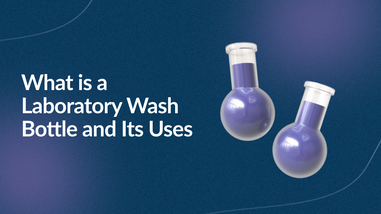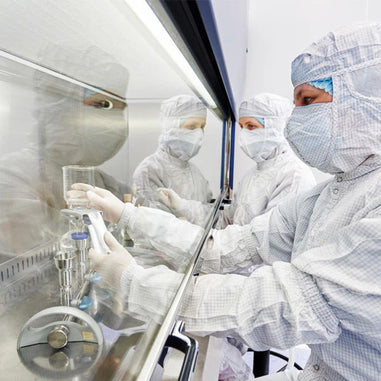- No products in the cart.
Laboratory wash bottles are crucial for maintaining cleanliness and preventing contamination in lab environments. From rinsing glassware to dispensing solvents precisely, the wash bottle uses in laboratory settings play a pivotal role in ensuring accurate, reliable, and consistent results.
Valued at $34 million in 2025, the global laboratory wash bottle market is expected to grow at a CAGR of 3.5% from 2025 to 2033, reflecting the rising need for laboratory cleanliness and safety.
This growth reflects the increasing importance of maintaining sterile and uncontaminated lab conditions in industries such as pharmaceuticals, biotechnology, and research.
At Lab Pro, we provide high-quality wash bottles designed to meet the needs of high-compliance labs.
Key Takeaways
-
Wash bottles are essential tools to maintain cleanliness in laboratories and prevent contamination.
-
They are primarily used for rinsing glassware and dispensing solvents like methanol, acetone, and ethanol.
-
Wash bottle uses in laboratory settings extend beyond cleaning to chemical storage and precise reagent handling.
-
Lab Pro offers a wide variety of wash bottles, designed to meet the needs of high-compliance laboratories.
What Is A Wash Bottle?
A wash bottle is a flexible plastic container with a nozzle used to direct a stream of liquid onto a surface, typically for cleaning lab equipment. It’s an indispensable tool in laboratory settings, helping to maintain cleanliness and prevent contamination during experiments.
Why Are Wash Bottles Critical In Laboratories?
Maintaining cleanliness in laboratories is essential for accurate results. Wash bottles are integral in preventing contamination by providing a controlled, directed stream of liquid. This ensures that lab equipment, including glassware and plasticware, remains free of unwanted residues.
The versatility of wash bottles makes them suitable for a variety of laboratory applications, including solvent handling, rinsing, and more.
This glassware or plasticware includes:
Beakers
1. Beakers, Low Form, Heavy Duty, 1000ml - BG1003-1000
Beakers are cylindrical glass containers with a flat bottom, used for mixing, heating, or holding liquids. The heavy-duty, low-form 1000ml beaker is especially useful for routine laboratory tasks where durability and volume capacity are important, such as preparing solutions or collecting samples.

Flasks
2. FLASK Volumetric 1000ML CL A w/STOP
Volumetric flasks are designed for precise measurement of liquid volumes. This 1000ml Class A flask with a stopper is used when accuracy is critical, such as preparing standard solutions for analytical chemistry.

Bottles
High-density polyethylene (HDPE) bottles are durable, lightweight containers used for safely storing and transporting chemicals, reagents, or samples. Their chemical resistance makes them suitable for acids, bases, and other lab liquids.

Test tubes
4. Test Tube Rack Set, Plastic Tubes - TTRSET-P
Test tubes are small cylindrical containers used for reactions, heating, or sample storage. This rack set with plastic tubes provides organization and safe handling during experiments, especially in teaching labs or routine testing.

Jars
5. JAR 16oz PolyP 89MM w/o Cap
Polypropylene jars are versatile containers for storing powders, granules, or bulk samples. Lightweight and chemical-resistant, they are used when easy access and storage stability are needed.

Watch glasses
6. WATCH Glass 3in/75mm PYREX - W5860-75
Watch glasses are shallow, concave pieces of glass used as covers for beakers to prevent contamination or splattering. They are also used for evaporating liquids or holding small samples.

Petri dishes
7. DISH PETRI 150x15MM PS 20/Pkg - D4373-3
Petri dishes are shallow, flat, round plates used for culturing microorganisms or growing cell cultures. The 150mm polystyrene version is commonly used in microbiology for streaking, isolating, or observing bacterial colonies.

Graduated cylinders
8. CYLINDER GRADUATED 500 Cl A
Graduated cylinders are tall, narrow vessels used for accurately measuring liquid volumes. A 500ml Class A cylinder provides precision in volume measurement, making it ideal for solution preparation and quantitative experiments.

Burettes
9. BURET (Burette) 10ML AUTO w/RES & Tef
Burettes are graduated glass tubes with stopcocks at the bottom, used to dispense precise volumes of liquid, particularly in titrations. The 10ml automatic burette with reservoir and Teflon parts allows for controlled and repeatable delivery of reagents.

Pipettes
10. CAPP-Pipette stand for up to 5 Capp mechanical pipettes, all models-C-05
Pipettes are precision tools used for transferring small, accurate volumes of liquid. A pipette stand keeps mechanical pipettes organized, upright, and free from contamination between uses.

Microscope slides
11. Microscope Slide Mailers, Pp, 2 Slides - 62102
Microscope slides are thin glass pieces used to hold samples for microscopic examination. Slide mailers protect prepared slides during transport or storage, ensuring samples remain intact for later analysis.

Stirring rods
12. Plastic Stirring Rod Pk/12 - 81405
Stirring rods are simple tools used to manually mix solutions. Plastic versions are lightweight, reusable, and resistant to breakage, making them suitable for everyday mixing in teaching or research labs.

Wash Bottle Uses In Laboratory
The wash bottle uses in laboratory are diverse and essential for keeping lab equipment free from contaminants.
The primary purpose of a wash bottle is cleaning, but there are other specialized functions:
-
Rinsing Glassware and Plasticware: Wash bottles are used to rinse laboratory containers such as beakers, flasks, test tubes, and graduated cylinders. This ensures that residues from previous experiments are removed. Considering that cleaning and washing tasks can account for roughly 60% of a university’s total water consumption, using wash bottles helps control and direct water or solvent flow more precisely, reducing unnecessary waste.
-
Dispensing Solvents: Wash bottles are often filled with solvents like methanol, acetone, and ethanol for various tasks, including cleaning, preparing samples, or diluting substances.
-
Chemical Storage: Wash bottles are also used for storing and dispensing chemicals and solvents, especially when labeled with proper safety information for easy identification.
-
Handling High-Vapor Pressure Reagents: Vented wash bottles are designed for safely handling chemicals that release vapors, preventing pressure buildup and ensuring safe chemical dispensing.
Also, read:
-
Behind the Scenes: How Lab Supplies Bring Hollywood Movie Props to Life
-
Maximizing Efficiency: Best Practices for Using Centrifuge Tubes
-
The Importance of Quality Control: Ensuring Safe Storage with Carboy Containers
What Are Wash Bottles Made Of?
Wash bottles are typically made from low-density polyethylene (LDPE), a flexible and durable plastic that resists thermal and chemical stress. LDPE is ideal for ensuring that the bottle can withstand squeezing pressure to force liquid out of the nozzle, whether it's a stream or a single drop.
Wash bottles come with various spout types to suit different laboratory needs:
-
Standard Spouts: Common in general laboratory cleaning tasks.
-
Integrated Spouts: For precise, directed application.
-
Vented Spouts: To handle chemicals with high vapor pressure and prevent dangerous leaks.

Lab Pro Wash Bottles: Tailored For Your Lab Needs
Lab Pro provides a wide selection of wash bottles designed to meet the rigorous standards of high-compliance laboratories. Made from LDPE, our bottles offer superior resistance to various solvents, ensuring reliable performance in any lab environment.
Key Features:
-
Flexible Nozzles: Easily direct liquid to hard-to-reach areas of lab equipment.
-
Variety of Sizes: Available in capacities from 125 ml to 1000 ml, plus smaller sizes like 4 oz., 8 oz., 16 oz., and 32 oz. for precise applications.
-
Safety Compliance: Features color-coded lids, chemical labels, and other safety measures for full regulatory compliance.
Built to withstand the demands of biotech, semiconductor, and pharmaceutical labs, Lab Pro’s wash bottles are essential for maintaining a clean, efficient lab environment.
Looking for the perfect wash bottle for your lab?
Explore Our Products
FAQs
1. What are the common uses of a wash bottle in a laboratory?
Wash bottles are used to rinse glassware, dispense solvents, and store chemicals. They help maintain cleanliness in the lab by preventing cross-contamination and ensure safe handling of hazardous substances, contributing to more accurate and reliable experimental results.
2. Can wash bottles be used for dispensing chemicals other than water?
Yes, wash bottles are commonly filled with solvents like acetone, ethanol, and methanol for cleaning, preparing solutions, or other lab tasks. It's important to properly label each bottle to ensure safety and correct identification of the chemicals stored inside, reducing risks in the lab.
3. Are Lab Pro wash bottles suitable for high-compliance labs?
Yes, Lab Pro’s wash bottles are made from LDPE, which offers excellent chemical and thermal resistance. They also feature safety elements like color-coded lids and chemical labels to meet regulatory standards, making them ideal for use in high-compliance labs such as pharmaceutical, biotech, and semiconductor environments.
4. What sizes do wash bottles come in?
Lab Pro’s wash bottles are available in sizes ranging from 4 oz., 8 oz., 16 oz., and 32 oz. for smaller tasks to 125 ml, 250 ml, 500 ml, and 1000 ml for general use. This variety ensures you have the right size for your specific laboratory needs.



















































